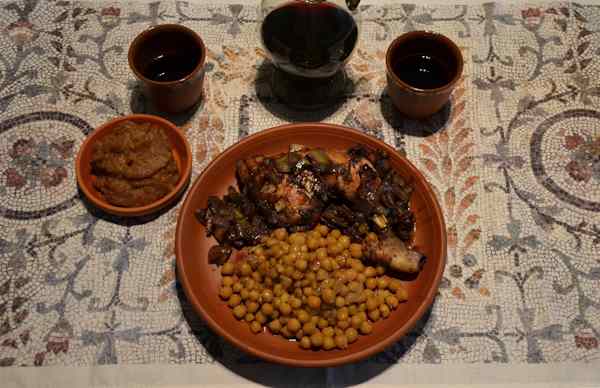Etiquette for dining in Ephesus was as contextual as it is today. In the homes of the upper class, food in ancient Ephesus was eaten lying on couches set around a table. It was customary for the Ephesians to lie down on their left elbows while eating. Meals were usually eaten with a spoon and served with a fork. Drinks were served in two-handled goblets made of silver, clay, or glass. Wealthy hosts wanted to impress their guests with astonishing delicacies and pleasing hospitality. No expense was spared for this.

The Ephesian diet in ancient times revolved around four basic foodstuffs that still dominate restaurant menus and kitchen tables even today: grains, vegetables, olive oil, and wine. Seafood, cheese, eggs, meat, and many kinds of fruit were also available for those who could buy them. Ephesians were also adept at processing and preserving food, using techniques such as pickling and storing in honey. Flavoring food with sauces, herbs, and exotic spices was another important element in Ephesian cuisine. Our knowledge of what and how the Ephesians ate was compiled from writings, wall paintings, mosaics, and even food remains from historical sites such as the Ephesus Terrace Houses.
Most commonly, wheat and barley made up the bulk of the diet for many and were particularly used for making bread and porridge. The most common fruits were apples, figs, and grapes, although pears, plums, dates, cherries, and peaches were also found.
Vegetables, on the other hand, consisted of typical types such as beans, lentils, and peas, except for broad beans. As an excellent source of protein, these grains were often mixed into bread. As for other vegetables, asparagus, mushrooms, onions, turnips, radishes, cabbage, lettuce, leeks, celery, cucumbers, artichokes, and garlic were used. Both fruits and vegetables were pickled with brine or vinegar, or preserved in wine, grape juice, or honey to preserve them until out-of-season consumption.
Because meat was an expensive product for many Ephesians, it was often prepared in small pieces or as sausages. Although poultry and game animals were important sources of meat, pork, calf, sheep, and goat meat were also used. Game animals such as rabbits, hares, wild boars, and deer were also raised in large and enclosed areas of the forest nearby Ephesus which can be even seen today.
An astonishing variety of birds were valued for their meat, including partridge, pheasant, goose, duck, black chicken, pigeon, magpie, plover, woodcock, and quail. Meats of all these animals could also be preserved by methods such as salting, drying, smoking, brine, and storage in honey.
If the Ephesians did not grow their own crop, they would get their food from a special market which is known as ”Macellum”. These markets were set up outdoors in the public squares of the city of Ephesus or in market buildings reserved for this business. In Ephesus, food markets were established daily from the first century BC.
In ancient Ephesus, baker’s shops had a sufficiently hot oven for bread making, and often customers brought their own bread dough and used the oven only to bake it. Alongside these businesses, however, cooking was mostly a household activity. Using a brasier, food was roasted, grilled, and boiled. In particular, spices offered an endless variety of flavors, and at least 142 different types of spices were identified in ancient sources.